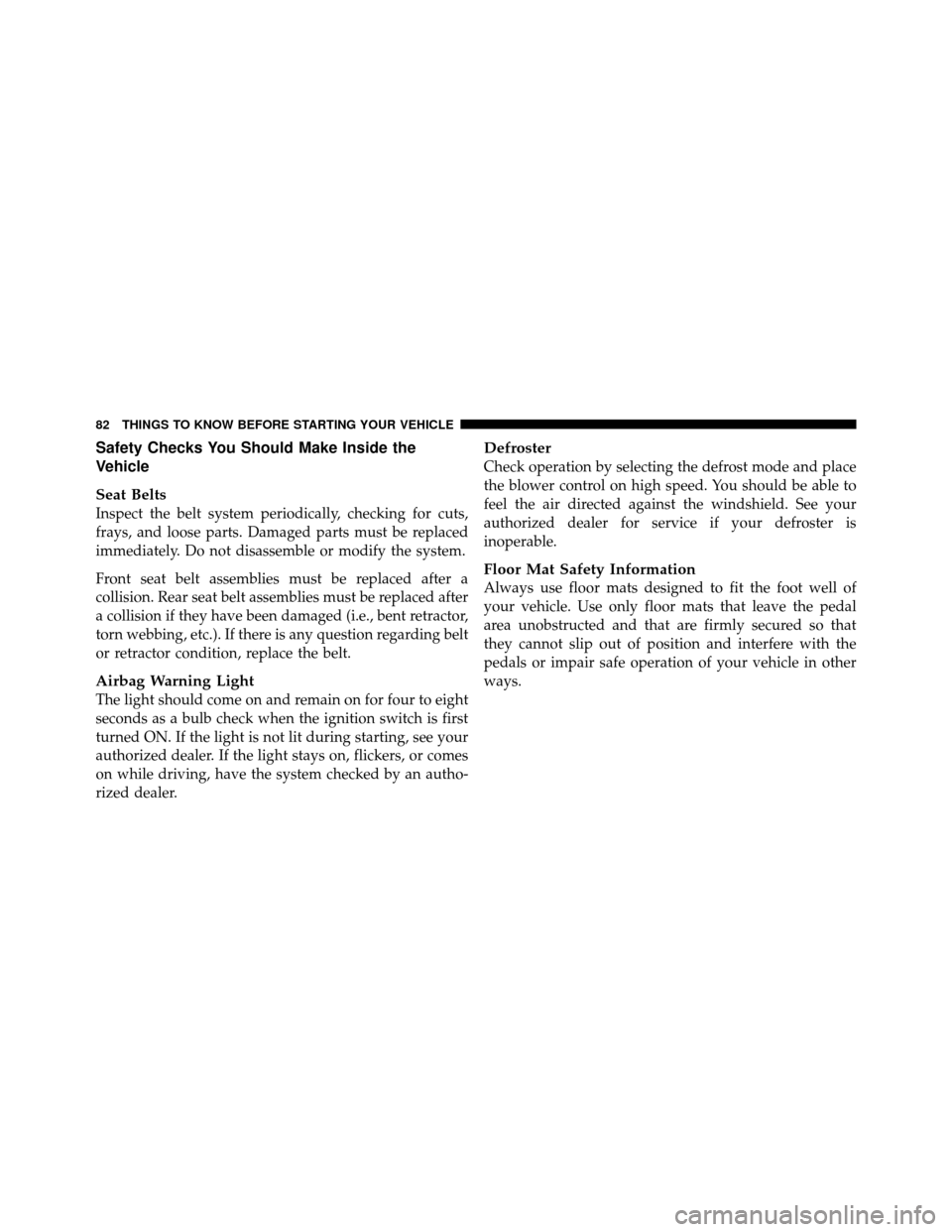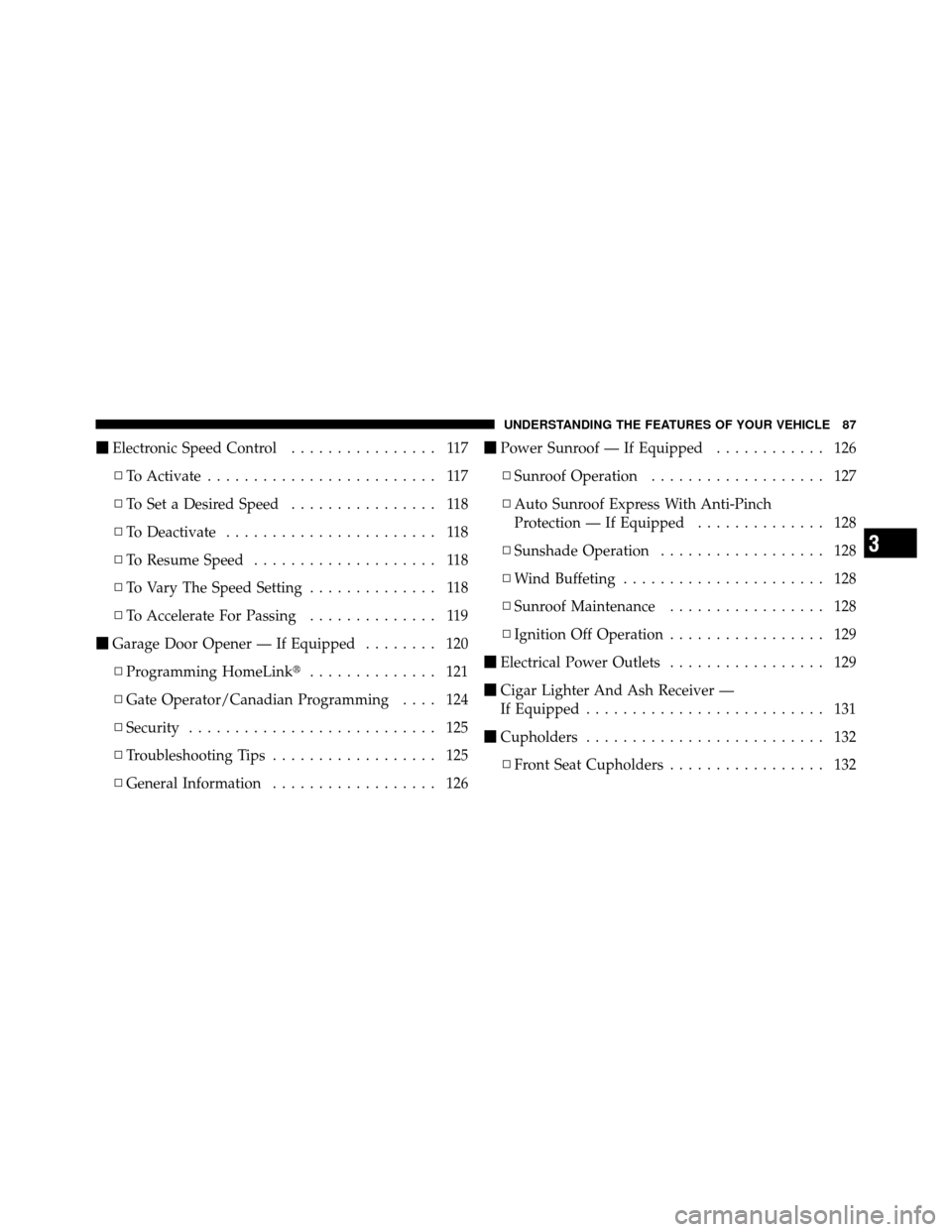Page 63 of 444

Also, the ORC turns on the Airbag Warning
Light in the instrument panel for approxi-
mately six to eight seconds for a self-check
when the ignition is first turned on. After the
self-check, the Airbag Warning Light will turn off. If the
ORC detects a malfunction in any part of the system, it
turns on the Airbag Warning Light, either momentarily
or continuously. A single chime will sound if the light
comes on again after initial startup.
It also includes diagnostics that will illuminate the instru-
ment cluster Airbag Warning Light if a malfunction is
noted that could affect the airbag system. The diagnostics
also record the nature of the malfunction.WARNING!
Ignoring the Airbag Warning Light in your instru-
ment panel could mean you won’t have the airbags to
protect you in a collision. If the light does not come
on, stays on after you start the vehicle, or if it comes
on as you drive, have an authorized dealer service the
airbag system immediately.
Driver and Passenger Airbag Inflator Units
The Driver and Passenger Airbag Inflator Units are
located in the center of the steering wheel and the right
side of the instrument panel. When the ORC detects a
collision requiring the Advanced Front Airbags, it signals
the inflator units. A large quantity of non-toxic gas is
generated to inflate the Advanced Front Airbags. Differ-
ent airbag inflation rates are possible, based on the
collision type and severity. The steering wheel hub trim
cover and the upper right side of the instrument panel
62 THINGS TO KNOW BEFORE STARTING YOUR VEHICLE
Page 65 of 444

covers the window. The airbag inflates in about 30 ms
(about one-quarter of the time that it takes to blink your
eyes) with enough force to injure you if you are not belted
and seated properly, or if items are positioned in the area
where the side curtain airbag inflates. This especially
applies to children. The side curtain airbag is only about
3-1/2 in (9 cm) thick when it is inflated.
Because airbag sensors estimate deceleration over time,
vehicle speed and damage are not good indicators of
whether or not an airbag should have deployed.
NOTE:In a rollover the pretensioners and/or SABIC
airbags may deploy on both sides of the vehicle.
Front and Side Impact Sensors
In front and side impacts, impact sensors can aid the
ORC in determining appropriate response to impact
events. Additional sensors in the ORC determine the
level of airbag deployment and provide verification.
Enhanced Accident Response System
In the event of an impact causing airbag deployment, if
the communication network remains intact, and the
power remains intact, depending on the nature of the
event the ORC will determine whether to have the
Enhanced Accident Response System perform the follow-
ing functions:
•Cut off fuel to the engine.
•Flash hazard lights as long as the battery has power or
until the ignition key is turned off.
•Turn on the interior lights, which remain on as long as
the battery has power or until the ignition key is
removed.
•Unlock the doors automatically.
If a Deployment Occurs
The front airbags are designed to deflate immediately
after deployment.
64 THINGS TO KNOW BEFORE STARTING YOUR VEHICLE
Page 68 of 444

Airbag Warning Light
You will want to have the airbags ready to
inflate for your protection in a collision. While
the airbag system is designed to be mainte-
nance free, if any of the following occurs, have
an authorized dealer service the system immediately.
•The Airbag Warning Light does not come on during
the six to eight seconds when the ignition switch is
first turned on.
•The Airbag Warning Light remains on after the six to
eight second interval.
•The Airbag Warning Light comes on intermittently or
remains on while driving.
NOTE: If the speedometer, tachometer, or any engine
related gauges are not working, the Occupant Restraint
Controller (ORC) may also be disabled. The airbags may
not be ready to inflate for your protection. Promptly
check the fuse block for blown fuses. Refer to the label located on the inside of the fuse block cover for the
proper airbag fuses. See your authorized dealer if the
fuse is good.
Event Data Recorder (EDR)
In the event of a collision, your vehicle is designed to
record up to five seconds of specific vehicle data param-
eters (see list below) in an event data recorder prior to the
moment of airbag deployment, or near deployment (if
applicable), and up to a quarter second of either high-
speed deceleration data or change in velocity during
and/or after airbag deployment or near-deployment.
EDR data is ONLY recorded if an airbag deploys, or
nearly deploys, and is otherwise unavailable.
NOTE:
1. A near-deployment event occurs when the airbag
sensor detects severe vehicle deceleration usually indica-
tive of a crash, but not severe enough to warrant airbag
deployment.
2
THINGS TO KNOW BEFORE STARTING YOUR VEHICLE 67
Page 70 of 444

3. Requested by police under a legal warrant.
4. Otherwise required by law.
Data parameters that are recorded:
•Diagnostic trouble code(s) and warning light status for
electronically-controlled safety systems, including the
airbag system
•Vehicle speed
•Engine RPM
•Brake switch status
•Pedal position
•And other parameters depending on vehicle
configuration
Child Restraints
Everyone in your vehicle needs to be buckled up all the
time, including babies and children. Every state in theUnited States and all Canadian provinces require that
small children ride in proper restraint systems. This is the
law, and you can be prosecuted for ignoring it.
Children 12 years and younger should ride properly
buckled up in a rear seat, if available. According to crash
statistics, children are safer when properly restrained in
the rear seats, rather than in the front.
WARNING!
In a collision, an unrestrained child, even a tiny baby,
can become a projectile inside the vehicle. The force
required to hold even an infant on your lap could
become so great that you could not hold the child, no
matter how strong you are. The child and others
could be badly injured. Any child riding in your
vehicle should be in a proper restraint for the child’s
size.
2
THINGS TO KNOW BEFORE STARTING YOUR VEHICLE 69
Page 83 of 444

Safety Checks You Should Make Inside the
Vehicle
Seat Belts
Inspect the belt system periodically, checking for cuts,
frays, and loose parts. Damaged parts must be replaced
immediately. Do not disassemble or modify the system.
Front seat belt assemblies must be replaced after a
collision. Rear seat belt assemblies must be replaced after
a collision if they have been damaged (i.e., bent retractor,
torn webbing, etc.). If there is any question regarding belt
or retractor condition, replace the belt.
Airbag Warning Light
The light should come on and remain on for four to eight
seconds as a bulb check when the ignition switch is first
turned ON. If the light is not lit during starting, see your
authorized dealer. If the light stays on, flickers, or comes
on while driving, have the system checked by an autho-
rized dealer.
Defroster
Check operation by selecting the defrost mode and place
the blower control on high speed. You should be able to
feel the air directed against the windshield. See your
authorized dealer for service if your defroster is
inoperable.
Floor Mat Safety Information
Always use floor mats designed to fit the foot well of
your vehicle. Use only floor mats that leave the pedal
area unobstructed and that are firmly secured so that
they cannot slip out of position and interfere with the
pedals or impair safe operation of your vehicle in other
ways.
82 THINGS TO KNOW BEFORE STARTING YOUR VEHICLE
Page 85 of 444
Periodic Safety Checks You Should Make Outside
the Vehicle
Tires
Examine tires for excessive tread wear and uneven wear
patterns. Check for stones, nails, glass, or other objects
lodged in the tread. Inspect the tread and sidewall for
cuts and cracks. Check the wheel nuts for tightness.
Check the tires (including spare) for proper pressure.
Lights
Have someone observe the operation of exterior lights
while you work the controls. Check turn signal and high
beam indicator lights on the instrument panel.
Door Latches
Check for positive closing, latching, and locking.
Fluid Leaks
Check area under vehicle after overnight parking for fuel,
engine coolant, oil, or other fluid leaks. Also, if gasoline
fumes are detected or if fuel, power steering fluid, or
brake fluid leaks are suspected, the cause should be
located and corrected immediately.
84 THINGS TO KNOW BEFORE STARTING YOUR VEHICLE
Page 87 of 444

▫Fold-Flat Passenger Seatback ............ 102
▫ Folding Rear Seat .................... 102
▫ Folding Rear Seat Center Armrest ........ 103
� To Open And Close The Hood ............ 104
� Lights ............................. 105
▫ Multifunction Lever .................. 105
▫ Headlights And Parking Lights .......... 106
▫ Automatic Headlights — If Equipped ...... 107
▫ Headlight Time Delay ................. 107
▫ Turn Signals ........................ 108
▫ Lane Change Assist ................... 108
▫ High/Low Beam Switch ............... 108
▫ Flash-To-Pass ....................... 108 ▫
Fog Lights — If Equipped .............. 109
▫ Daytime Running Lights — If Equipped .... 109
▫ Lights On Reminder .................. 110
▫ Instrument Panel Dimmer .............. 110
▫ Map/Reading/Interior Lights ............111
� Windshield Wipers And Washers .......... 112
▫ Intermittent Wiper System .............. 113
▫ Windshield Washers .................. 114
▫ Mist Feature ........................ 114
▫ Headlights With Wipers Feature (Available
With Automatic Headlights Only) ......... 115
� Tilt/Telescoping Steering Column .......... 116
86 UNDERSTANDING THE FEATURES OF YOUR VEHICLE
Page 88 of 444

�Electronic Speed Control ................ 117
▫ To Activate ......................... 117
▫ To Set a Desired Speed ................ 118
▫ To Deactivate ....................... 118
▫ To Resume Speed .................... 118
▫ To Vary The Speed Setting .............. 118
▫ To Accelerate For Passing .............. 119
� Garage Door Opener — If Equipped ........ 120
▫ Programming HomeLink� .............. 121
▫ Gate Operator/Canadian Programming .... 124
▫ Security ........................... 125
▫ Troubleshooting Tips .................. 125
▫ General Information .................. 126 �
Power Sunroof — If Equipped ............ 126
▫ Sunroof Operation ................... 127
▫ Auto Sunroof Express With Anti-Pinch
Protection — If Equipped .............. 128
▫ Sunshade Operation .................. 128
▫ Wind Buffeting ...................... 128
▫ Sunroof Maintenance ................. 128
▫ Ignition Off Operation ................. 129
� Electrical Power Outlets ................. 129
� Cigar Lighter And Ash Receiver —
If Equipped .......................... 131
� Cupholders .......................... 132
▫ Front Seat Cupholders ................. 132
3
UNDERSTANDING THE FEATURES OF YOUR VEHICLE 87